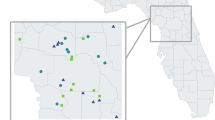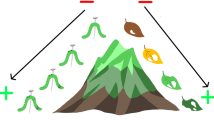Abstract
Predator–predator, predator–prey, and prey–prey associations among nine species of mites were studied in a plot of 100 “Red Delicious” apple (Malus pumila Miller) trees from 1990 to 1997. In 1990, seven-year-old trees were inoculated with Panonychus ulmi (Koch), Tetranychus urticae Koch (Acari: Tetranychidae) or both, and sprayed with azinphosmethyl (alone or plus endosulfan), or nothing. The species Zetzellia mali (Ewing) (Acari: Stigmaeidae), Amblyseius andersoni Chant (Acari: Phytoseiidae), Eotetranychus sp., Bryobia rubrioculus (Scheuten) (Acari: Tetranychidae), and Aculus schlechtendali Nalepa (Acari: Eriophyidae) were already present or immigrated into plots, and Galendromus occidentalis (Nesbitt) and Typhlodromus pyri Scheuten (Acari: Phytoseiidae) were introduced. Yule's V association index was used to measure positive, neutral, or negative interspecific associations for each species pair, because of its robustness with spatially autocorrelated data. We found that pesticide and release treatments did not greatly affect the association results, but there were strong seasonal differences. Predator–predator associations were the strongest and most consistent, showing negative associations in the early and mid seasons, and neutral ones in late season. Negative associations of T. pyri with other predators were the strongest, which is consistent with evidence that this mite can detect other predators on a leaf. Predator–prey seasonal associations were mixed, with some positive and others negative, with most significant associations occurring in the mid season. One prey–prey interaction was positive, again in mid season, most likely because of similar habitat preferences.
Similar content being viewed by others
References
Cole, L.C. 1949. The measurement of interspecific association. Ecology 30: 411-424.
Croft, B.A. 1994. Biological control of apple mites by a phytoseiid mite complex and Zetzellia mali (Acari: Stigmaeidae): Long-term effects and impact of azinphosmethyl on colonization by Amblyseius andersoni (Acari: Phytoseiidae). Environ. Entomol. 23: 1317-1325.
Croft, B.A. andCroft, M.B. 1996. Intra-and interspecific predation among adult female phytoseiid mites (Acari: Phytoseiidae): effects on survival and reproduction. Environ. Entomol. 25: 855-858.
Croft, B.A. andHoying, S.A. 1977. Competitive displacement of Panonychus ulmi (Acarina: Tetranychidae) by Aculus schlechtendali (Acarina: Eriophyidae) in apple orchards. Canad. Entomol. 109: 1025-1034.
Croft, B.A.,Kim, S.S. andKim, D.I. 1996. Intra-and interspecific predation on four life stage groups by the adult females of Metaseiulus occidentalis, Typhlodromus pyri, Neoseiulus fallacis, and Amblyseius andersoni. Exp. Appl. Acarol. 20: 435-444.
Croft, B.A. andMacRae, I.V. 1992a. Biological control of apple mites by mixed populations of Metaseiulus occidentalis (Nesbitt) and Typhlodromus pyri Scheuten (Acari: Phytoseiidae). Environ. Entomol. 21: 202-209.
Croft, B.A. andMacRae, I.V. 1992b. Persistence of Typhlodromus pyri and Metaseiulus occidentalis (Acari: Phytoseiidae) on apple after inoculative release and competition with Zetzellia mali (Acari: Stigmaeidae). Environ. Entomol. 21: 1168-1177.
Croft, B.A. andMacRae, I.V. 1993. Biological control of apple mites: impact of Zetzellia mali (Acari: Stigmaeidae) on Typhlodromus pyri and Metaseiulus occidentalis (Acari: Phytoseiidae). Environ. Entomol. 22: 865-873.
Croft, B.A. andSlone, D.H. 1997. Equilibrium densities of European red mite (Acari: Tetranychidae) after exposure to three levels of predaceous mite diversity on apple. Environ. Entomol. 26: 391-399.
Dale, M.R.T.,Blundon, D.J.,MacIsaac, D.A. andThomas, A.G. 1991. Multiple species effects and spatial autocorrelation in detecting species associations. J. Veg. Sci. 2: 635-642.
Doutt, R.L. andDeBach, P. 1964. Some biological control concepts and questions, In: Biological Control of Insect Pests and Weeds, P. DeBach (ed.), pp. 118-142. Reinhold, New York.
Ehler, L.E. 1992. Guild analysis in biological control. Environ. Entomol. 21: 26-40.
Janson, S. andVegelius, J. 1981. Measures of ecological association. Oecologia 49: 371-376.
Jones, D. 1984. Use, misuse, and role of multiple-comparison procedures in ecological and agricultural entomology. Environ. Entomol. 13: 635-649.
MacRae, I.V. andCroft, B.A. 1993. Influence of temperature on interspecific predation and cannibalism by Metaseiulus occidentalis and Typhlodromus pyri (Acarina: Phytoseiidae). Environ. Entomol. 22: 770-775.
MacRae, I.V. andCroft, B.A. 1996. Differential impact of egg predation by Zetzellia mali (Acari: Stigmaeidae) on Metaseiulus occidentalis and Typhlodromus pyri (Acari: Phytoseiidae). Exp. Appl. Acarol. 20: 143-154.
McCulloch, C.E. 1985. Variance tests for species association. Ecology 66: 1676-1681.
McMurtry, J.A. andCroft, B.A. 1997. Life-styles of phytoseiid mites and their roles in biological control. Ann. Rev. Entomol. 42: 291-321.
Mendenhall, W. 1968. Introduction to Probability and Statistics. 2nd edn, Wadsworth Publishing Company, Belmont, CA.
Overmeer, W.P.J. 1985. Diapause, In: Spider Mites. Their Biology, Natural Enemies and Control, W. Helle andM.W. Sabelis (eds.), Vol. 1b, pp. 95-102. World Crop Pests, Elsevier, Amsterdam.
Palmer, M.W. andvan der Maarel, E. 1995. Variance in species richness, species association, and niche limitation. Oikos 73: 203-213.
Pielou, E.C. 1977. Mathematical Ecology. 2nd edn. Wiley, New York.
Roxburgh, S.H. andChesson, P. 1998. A new method for detecting species associations with spatially autocorrelated data. Ecology 79: 2180-2192.
Sabelis, M.W. 1985. Reproductive Strategies, In: Spider Mites, Their Biology, Natural Enemies and Control, W. Helle andM.W. Sabelis (eds.), Vol. 1a, pp. 265-278. World Crop Pests, Elsevier, Amsterdam.
Saito, Y. 1985. Life types of spider mites, In: Spider Mites, Their Biology, Natural Enemies and Control, W. Helle andM. W. Sabelis (eds.), Vol. 1a, pp. 253-264. World Crop Pests, Elsevier, Amsterdam.
Santos, M.A. 1991. Searching behavior and associational response of Zetzellia mali (Acarina: Stigmaeidae). Exp. Appl. Acarol. 11: 81-87.
Schausberger, P. 1997. Inter-and intraspecific predation on immatures by adult females in Euseius finlandicus, Typhlodromus pyri and Kampimodromus aberrans (Acari: Phytoseiidae). Exp. Appl. Acarol. 21: 131-150.
Schausberger, P. 1999a. Juvenile survival and development in Euseius finlandicus, Typhlodromus pyri and Kampimodromus aberrans (Acari: Phytoseiidae) feeding on con-and heterospecific immatures, In: Ecology and Evolution of the Acari, J. Bruin,L.P.S. van der Geest andM.W. Sabelis (eds.), pp. 367-374. Kluwer Academic Publishers, Dordrecht, The Netherlands.
Schausberger, P. 1999b. Predation preference of Typhlodromus pyri and Kampimodromus aberrans when offered con-and heterospecific immature life stages. Exp. Appl. Acarol. 23: 389-398.
Schausberger, P. andCroft, B.A. 1999. Predation on and discrimination between conand heterospecific eggs among specialist and generalist phytoseiid mite species (Acari: Phytoseiidae). Environ. Entomol. 28: 523-528.
Schluter, D. 1984. A variance test for detecting species associations, with some example applications. Ecology 65: 998-1005.
Slone, D.H. andCroft, B.A. 1998a. Detecting differences in arthropod aggregation by comparing the number of occupied sample units. Entomol. Exp. Appl. 87: 59-66.
Slone, D.H. andCroft, B.A. 1998b. Spatial aggregation of apple mites (Acari: Phytoseiidae, Stigmaeidae, Tetranychidae) as measured by a binomial model: Effects of life stage, reproduction, competition, and predation. Environ. Entomol. 27: 918-925.
Southwood, T.R.E. 1991. Ecological Methods with Particular Reference to the Study of Insect Populations. 2nd edn., Chapman and Hall, London.
Tavaré, S. andAltham, P.M.E. 1983. Serial dependence of observations leading to contingency tables, and corrections to chi-squared statistics. Biometrika 70: 139-144.
van der Geest, L.P.S. 1985. Aspects of physiology, In: Spider Mites, Their Biology, Natural Enemies and Control, W. Helle andM.W. Sabelis (eds), Vol. 1a, pp. 253-264. World Crop Pests, Elsevier, Amsterdam.
Author information
Authors and Affiliations
Rights and permissions
About this article
Cite this article
Slone, D., Croft, B. Species Association Among Predaceous and Phytophagous Apple Mites (Acari: Eriophyidae, Phytoseiidae, Stigmaeidae, Tetranychidae). Exp Appl Acarol 25, 109–126 (2001). https://doi.org/10.1023/A:1010640631355
Issue Date:
DOI: https://doi.org/10.1023/A:1010640631355




